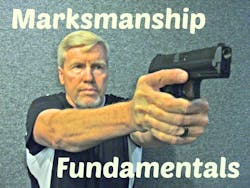Regardless of how long you’ve been on the job, it never hurts to review the basics that launched your career. Today, I’d like to quickly go over some of the basic shooting fundamentals. There exists a huge disparity among departments regarding range time. Some have quarterly quals, while others may only shoot once a year. Despite the inability to train with your department, nothing prevents you from training on your own. And it need not be live fire. Dry firing also helps to keep you intimately familiar with your weapon and its functionality. So let’s review.
Stance or platform
I wrote about stance in an article, “The Fighting Stance,” in June of 2012. In it I made the distinction between shooting qualification stances and combat/gun fighting stances. The two differ in that the gun fighting stance is basically the same that one would take if they were about to square off with an opponent in a fistfight. It’s basically isosceles—feet shoulder width apart, knees slightly bent, one foot slightly ahead of the other. This position affords front and rear stability and allows for a 180 degree arc of peripheral vision. A good solid platform helps absorb recoil as well.
Grip
It’s very important to obtain and maintain a correct grip on your handgun to aid in accuracy and control recoil. Ideally, the hands should wrap around the gun and the web of your hand be high on the tang, also known as the back strap or beavertail. This placement allows for less muzzle flip and recoil control. Your grip should be firm, but not overpowering. Trying to muscle the gun will only cause you to be inaccurate. Wrists should be close together, and thumbs should be pointing downrange alongside the slide. The heel of your support hand should be covering any exposed part of the gun not covered by the fingers of the shooting hand.
Sight alignment
Simply put, sight alignment is placing the front sight inside the rear sight so that the tops and sides have equal light or spacing. Some weapons have sights that are thicker than others—Glocks are one. Of the two components, the front sight is most important. In a gunfight if you put the front sight on your target, once you’ve drawn down and the body achieves its natural aiming point, you’ll likely achieve a solid hit. Shooting guru Jeff Cooper coined the term, “flash front sight picture.” He said one only needs to flash or lightly focus on the front sight at most distances.
Sight picture
Now that you’re satisfied with your sight alignment, place that combination on what you’re shooting at—that’s known as sight picture. Once you’ve done that, notice that the target and rear sight should be blurry, while the front sight should not. In a gunfight if there isn’t sufficient time to obtain sight alignment and sight picture, bring the gun up to your eye and use the rear frame as a sighting tool. You’ll still likely hit what you’re shooting at, particularly at short distances.
Breathing
Don’t hold your breath while you shoot. If you have the presence of mind to think about breathing, breathe deeply through your nose and let it out through your mouth. Taking a couple of deep breaths will help control stress and heart rate.
Trigger control/management
This is nothing more than not jerking or slapping the trigger. Controlling the trigger means applying steady pressure rearward which aids in maintaining sight alignment and sight picture. I don’t worry about trigger reset, but rather firing from the pressure wall which is the point when the gun fires. Whether you are controlling the trigger quickly, as in a gun battle, or at practice, always try to be cognizant of controlling the trigger.
Follow through
By itself follow through doesn’t sound very important, but like the aforementioned fundamentals it can be the difference between hitting and not hitting your target/adversary. Following through on a shot means staying on the sights and trigger through the shot. In target shooting, not following through on a shot can mean a low hit or even a miss, since many shooters will quickly look to see where their round hit or move on to the next target. In a gunfight, not following through and turning to another adversary can mean missing completely.
I consider the above points to be basic to good marksmanship. Whether you practice with live fire or dry, the outcome will be the same. Your familiarity with your weapon and its functionality, combined with your abilities, will give you confidence and added accuracy whenever you must draw your weapon. The key is to practice, practice, practice.
Stay Safe, Brothers & Sisters!

John Wills
John M. Wills is a former Chicago police officer and retired FBI agent. He is a freelance writer and award-winning author in a variety of genres, including novels, short stories and poetry. John also writes book reviews for the New York Journal of Books, and is a member of the National Book Critics Circle. His new book, The Year Without Christmas, is available now. Visit John at: www.johnmwills.com.



